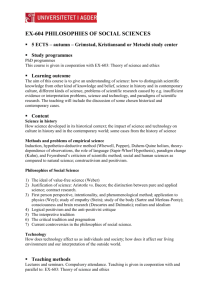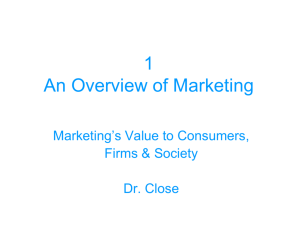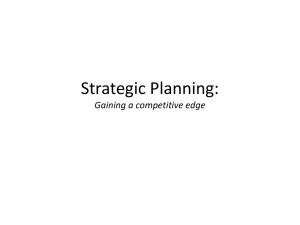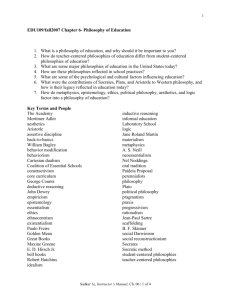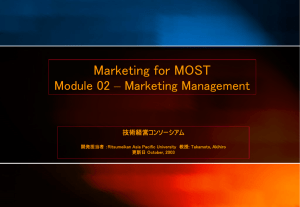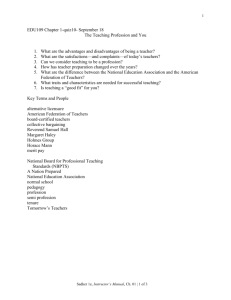Running Head: BEGINNING PHILOSOPHIES OF EDUCATION
advertisement
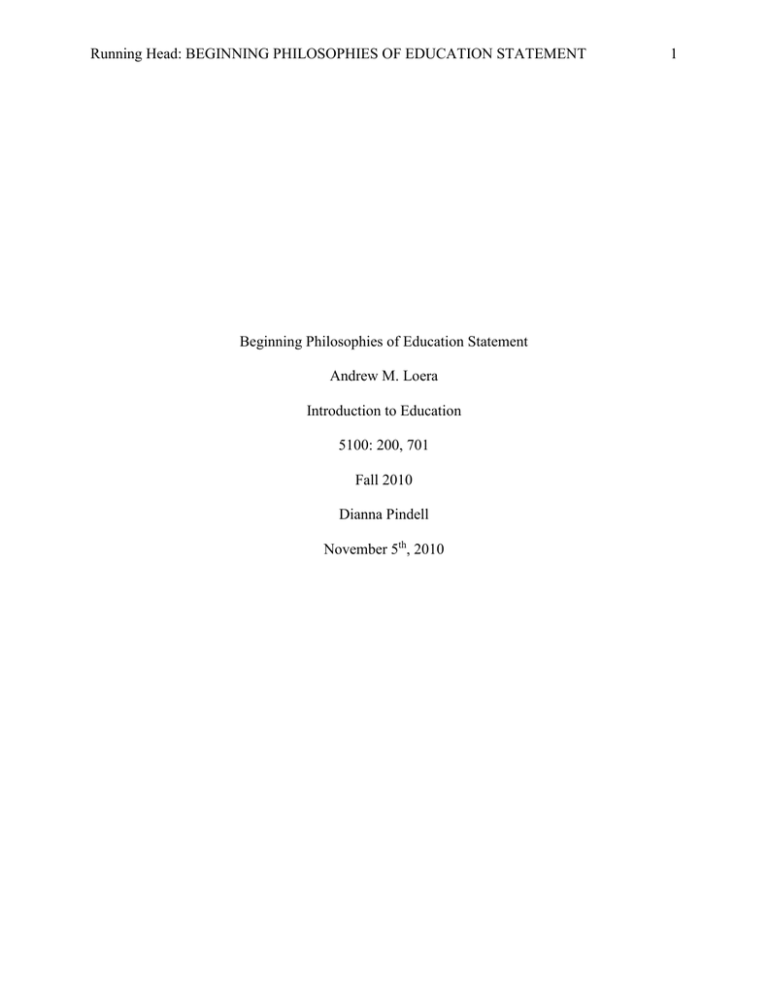
Running Head: BEGINNING PHILOSOPHIES OF EDUCATION STATEMENT Beginning Philosophies of Education Statement Andrew M. Loera Introduction to Education 5100: 200, 701 Fall 2010 Dianna Pindell November 5th, 2010 1 Running Head: BEGINNING PHILOSOPHIES OF EDUCATION STATEMENT 2 Introduction Teaching has long been a profession of my family. My great grandfather, grandfather, grandmother, great aunt, and my mother have all been educators. I feel that through my experiences growing up around these individuals I have been able to gain an extremely accurate concept of what an exceptional teacher is. I believe that teaching is a profession that gives a person the ability to help many students throughout a career, and that is exactly what I want to do: help. When I was in elementary school my grandmother was my principal and my mother was a teacher in the same building. Needless to say, I was on a short leash. During my time in elementary school I began to see that being a teacher meant more than teaching students. It meant becoming involved in the community, meeting new families, and working together to reach goals. At this time in my life I was able to experience school from a student’s perspective while also experience school from a teacher and principal’s perspective. This allowed me to gain a better understanding of the education system as I grew older, and I think it is what ultimately made me want to become an educator. I want to give students the best opportunity possible to excel and become successful contributing members of society. I will do this by adhering to Ohio standards for the profession of teaching, developing a well-rounded teaching philosophy, respecting diversity within the classroom, and exploring the purposes of schooling in a democratic society. Standards for Teaching As a new teacher in Ohio I must strive to address every Ohio teacher standard, but in reality there will be standards which I will excel at and standards that will be points of growth for me. There will also be standards that I must more readily address than others. Some standards Running Head: BEGINNING PHILOSOPHIES OF EDUCATION STATEMENT 3 may appeal to me more than others, which is not to say that one standard is more important than another. I believe I will be readily addressing the standard: “Teachers understand and use varied assessments to inform instruction, evaluate and ensure student learning” (Ohio Department of Education, 2010 [ODE]). This standard must be readily addressed because as a new teacher I must assess my students’ knowledge of the subject I will be teaching. I must motivate my students to succeed and achieve their full potential through goal setting and modified instruction. I can do this by asking my students to set goals before they take tests in order to motivate them to achieve high grades. I will also be readily addressing the standard: “Teachers plan and deliver effective instruction that advances the learning of each individual student.” (ODE, 2010) This standard must be addressed readily due to its direct effect on students. To me the standard means, a teacher must articulate exactly what is expected of the students and use skills and technology to make sure every student is learning. This can be done by providing students with rubrics for projects that I assign to the class. There are a couple standards that appeal to me and I feel I will be accomplished in. First, “teachers understand student learning and development, and respect the diversity of the students they teach” (ODE, 2010). This standard is appealing to me because often times there is a diverse group of students in the class and students can learn from one another, whether it be diverse cultures, language, skills, or experiences. As a teacher, I must know my students in order to identify with them and also determine students’ behavior and learning patterns. Second, “teachers know and understand the content area for which they have instructional responsibility” (ODE, 2010). I feel this standard is one which I would also be readily addressing. Teachers must Running Head: BEGINNING PHILOSOPHIES OF EDUCATION STATEMENT 4 know their content for what they teach, and I happen to really love the content I will be teaching. Through my compassion for my content area I will be motivated to use strategies and skill developed specifically from my content area. I will have no problem connecting content to relevant life experiences. As a new teacher there will be specific areas that I will be especially new to, such as classroom management and administration communication. This leads me to believe points of growth will be necessary for me for the standard: “teachers create learning environments that promote high levels of learning and achievement for all students” (ODE, 2010). I do not believe that I will not be able to achieve this standard, but I think the only way to achieve this standard is through practice. No new teacher is going to walk into a classroom and create an optimum learning environment. It will take some trial and error to become an outstanding classroom manager. The next standard which I believe will be a point of growth for me as a new educator is “Teachers collaborate and communicate with students, parents, and other educators, administrators, and the community to support student learning” (ODE, 2010). I will strive to communicate and collaborate with students, parents, and other educators and administrators, but like becoming a good classroom manager, this too will take practice. I will collaborate and communicate with all, but I need to determine the best ways to do that. Whether it means calling parents, sending newsletters, emailing administrators, conferencing, I will attain this teaching standard. I will continue to reflect on my professional practice to ensure personal growth toward academic excellence by achieving the Ohio teaching standard “Teachers assume responsibility for professional growth, performance and involvement as an individual and as a member of a Running Head: BEGINNING PHILOSOPHIES OF EDUCATION STATEMENT 5 learning community” (ODE, 2010). I will consistently take advantage of opportunities to positively impact teaching quality, student achievement, and school improvements. As a teacher I will become a lifelong learner and a member of the community of learners. One of the most important aspects of being a teacher is reflection. I will reflect upon my teaching techniques and how effective they are for teaching my students. Through hard work, dedication and compassion for teaching I believe I will become a successful teacher. I will achieve all of Ohio’s teaching standards; some standards will be more readily addressed and some standards will be points of growth for me. Instructional Philosophy In order to be an effective educator a teacher must first understand the five major philosophies of education; Essentialism, Perennialism, Progressivism, Social Reconstructionism, and Existentialism. I believe that a teacher must use a mixture of all of the philosophies of education to reach all of the students in any particular class. The philosophies that appeal most to me are Essentialism and Progressivism. As a result, I will most likely use these two philosophies the most (Sadker, Sadker & Zittleman, 2008). Essentialism is a teacher-centered philosophy according to, “Teachers, Schools, and Society” 8th edition Ohio. The focus is on the teacher transmitting knowledge, information, and skills to students with an emphasis on discipline. Essentialists tend to teach in a traditional way incorporating essential skills. These teachers promote character development, reasoning, patriotism, and academic knowledge (Sadker, 2008). Progressivism, however, is a student-centered philosophy which focuses more on individual needs and contemporary relevance. A progressive teacher will use real-world experiences of students and finds meaning for students to learn content (Sadker, 2008). Running Head: BEGINNING PHILOSOPHIES OF EDUCATION STATEMENT 6 At times these philosophies contradict each other, but I feel that each have certain aspects that positively contribute in student learning and achievement. For example, based on my philosophy of Essentialism, most of the time I will be conducting the direct teaching model. This strategy is centered around structured lessons conducted by the teacher in order to pass knowledge to students through teacher guided practice and feedback. This strategy also focuses on making sure that a high percentage of students understand the content, through guided practice and reviews, before moving forward (Sadker, 2008). Another teaching strategy that I will undoubtedly use based on the second strategy that appeals to me is “problem-based learning”. This progressive strategy addresses the real-world implications and associations with content being taught. In other words, it helps students to see the reason why something is being taught. Problem based learning helps students to learn cooperation and higher order thinking, while incorporating different subjects into problem solving (Sadker, 2008). Based on the University of Akron, College of Education I would use knowledge and technology is various ways to address student learning. As a professional educator I will use the knowledge I have received from the University of Akron, my own personal studies, and my life experiences to teach my students. The knowledge I am referring to is not only factually based knowledge of my content area, but also teaching techniques and organizational skills that lead to successful courses in which I will teach (College of Education, 2010). Technology is what drives our world forward. As a professional educator, without the use of technology in the classroom I would be placing my students at a disadvantage. Technology can help bring information into the classroom faster and therefore more accurately. As a professional educator I will use various forms and the latest technology available to me to help Running Head: BEGINNING PHILOSOPHIES OF EDUCATION STATEMENT 7 teach my students not only my content, but also about the technology being used at the time. I will assign projects that incorporate the use of technology such as the internet, Microsoft Office, libraries, and internet databases to teach proper research skills and use of technology. Assistive technology in the classroom will help students with disabilities learn more efficiently (College of Education, 2010). Diversity of Learners Diversity has become an important aspect of teaching due to the fact that educators have better access to accurate information and the sheer fact that the world is becoming smaller every minute, and the chances of having a culturally diverse classroom are increasing. Students who are part of culturally diverse classrooms not only have more of an opportunity to learn to be accepting of other cultures and races, but it also helps to learn about those cultures as well. Another aspect of diversity in the classroom is the diversity of learning from student to student. It is clear that not every student learns with the same techniques or at the same pace as other students. It is very important for me as a professional educator to strive to cater toward my students’ needs and the diverse ways in which they learn. I will encounter countless diverse students in my classroom from students with learning disabilities, students from other countries or cultures, different social economic statuses, to gifted students. A potential problem facing our education system today is how educators can produce an environment that ensures responsiveness from diverse populations of students. My answer to this question is by using various activities and strategies such as developing a multicultural curriculum, practicing differentiated instruction, identifying potential students with disabilities, and being a culturally responsive teacher. According to James Banks in Teachers, Schools, and Society 8th edition, there are four steps in creating a multicultural curriculum for students. Step Running Head: BEGINNING PHILOSOPHIES OF EDUCATION STATEMENT 8 one focuses on identifying the heroes of different ethnicities (Sadker, 2008). For example, the class could spend one day learning about Fredrick Douglass or Jackie Robinson. The second step is called the “additive approach.” This step is geared towards designating a specific portion of the month or grading period to cultural diversity. For example, the month of February has been designated as Black History Month. This provides a bit of a change of pace for students and an opportunity to have fun and meaningful activities. The third step in this process is called “Transformation Approach.” This step is an attempt to step back from our content and really examine it. Make sure that what is being taught is accurate (Sadker, 2008). If I were teaching about the American Revolution, I would explain that Americans felt that England was taking advantage of them, while the British felt that by not charging higher taxes, the thirteen colonies were not pulling their proverbial weight. The last level, “Social Action,” refers to schools as a whole taking on social issues to ensure a safe and productive environment for all students. I feel as a teacher I cannot simply change my curriculum, but I can make small changes to address the diversity in my classroom. I believe I can take all four steps into consideration to become a culturally responsive teacher (Sadker, 2008). Becoming a culturally responsive teacher does not end at curriculum. I must do my best to make sure students not just from different racial and ethnic backgrounds are responsive, but also those who come from different economic backgrounds. This includes making sure my students are not coming to class on an empty stomach or from an unsafe home. This is not my responsibility alone, but as an educator I must be aware and ready to help students. I will create a learning environment that is inviting to students and encourages learning. I will give students the tools to be successful. Whether it is showing students how to use a library card properly or Running Head: BEGINNING PHILOSOPHIES OF EDUCATION STATEMENT 9 use internet databases for research, I will not let students of a lesser economic background be hindered from education. Based on the University Of Akron’s College Of Education Principle of Diversity, I will demonstrate respect for diversity in and outside the classroom (College of Education, 2010). I will demonstrate respect by creating a good student-teacher relationship with all of my students in an effort to get to know who they are and what background they come from. This will help me to differentiate my teaching and incorporate meaningful content for my diverse learners. I will ensure that all of my students feel safe from racial slurs and stereotypes in my classroom. I will not tolerate disrespect of others cultures. The truth of the matter is, every culture has knowledge to contribute towards educating students and it would be a shame for a teacher not to take full advantage of using diversity in the classroom to teaching students to the fullest extent possible. Purpose of Schooling in a Democratic Society Our founding fathers had differing views on education, but who was right? Thomas Jefferson believed that all white children should have the opportunity to attend school at the government’s expense. The reason Jefferson believed this was due to the fact that society held white males higher in society. These schools’ curriculum consisted of mastering languages such as Greek and Latin, and were only in operation for about 3 months out of the year. However, Benjamin Franklin envisioned Academies which taught practical skills such as mathematics, astronomy, navigation, and bookkeeping. Tuition was not free or provided by the government, students had to be able to pay out of pocket. The first academy was opened by Benjamin Franklin and was named Franklin Academy (Sadker, 2008). Running Head: BEGINNING PHILOSOPHIES OF EDUCATION STATEMENT 10 I believe that each of these two great men had strengths in their ideas, but each also had flaws. Thomas Jefferson felt that students should learn Latin and Greek. This is understandable because at the time his upbringing from a wealth family, that is exactly what he learned, and he was successful so why not do that for everyone? On the other side of the spectrum Benjamin Franklin felt that students needed to learn practical skills in order to be successful. This makes sense when reflection of Franklin’s life is made. He grew up poor and self taught. He had many skills which made him successful. He knew that not every person was going to hold positions of power and great wealth, so people must know basic skills. When taking these two ideas into account I believe that the current educational system has identified more with Franklin’s idea that students need to learn practical information and skill in order to be successful. In other words, we cannot waste time teaching irrelevant information. From the perspective of cost and tuition, Franklin felt that all white males should receive a government funded education. However, Franklin felt that any student, male or female, should receive a proper education as long as he or she could pay tuition. From this perspective I feel that the current education system identifies with Jefferson because we have enacted laws that require the government to provide a free and appropriate public education to all students regardless of race, gender, or disability. After reflecting on Jefferson and Franklins’ view of schools I believe that the purpose of schools is to ready students to become leaders in society. Eventually all the students we teach will have roles in society, some will even become President of the United States. It is our responsibility and duty as educators to prepare students for what lies ahead and the vehicle for that preparation is the public school system. Running Head: BEGINNING PHILOSOPHIES OF EDUCATION STATEMENT 11 The University of Akron College of Education core principles promote equal access to all students throughout. The first principle, Knowledge, promotes equal access because as teachers we must have knowledge of our students and the different backgrounds they come from in order to effective teach them. The second principle, Technology, promotes equal access by using technology to support learning for all students, even those with disabilities who may need special technologies to service learning. The third principle, Diversity, is an explanation of equal access in itself. Teachers must be aware and accepting of diversity of students, and view diversity as strength of a class, not a hindrance. The last principle, Ethics, promotes equal access because in order to be ethical professional teachers, it must recognized that one of our founding beliefs as a nation, equal opportunity, starts with education (College of Education, 2010). Conclusion I hope that in practicing the professional standards for teaching, developing a wellrounded instructional philosophy, respecting the diversity of learners, and understanding the purpose of schooling in a democratic society I will become an effective educator. I do not want to be just another teacher. I want to be a teacher that actively engages students in my class and one who can motivate students by tapping into their interests. If I can educate my students in my content area and help them achieve high grades, then hopefully I have done my job. If I can help my students become successful contributors to society then I know I have done my job. Running Head: BEGINNING PHILOSOPHIES OF EDUCATION STATEMENT References Sadker, David; Sadker, Myra; Zittleman, Karen. Teachers, Schools, and Society. 8th Edition, Ohio Edition. New York: McGraw-Hill Companies, Inc, 2008. University of Akron, College of Education Principles. 2010. Ohio Department of Education (2010). Ohio standards for the teaching profession. Columbus, OH. 12
